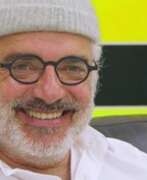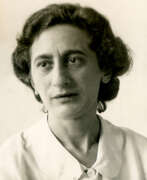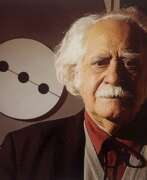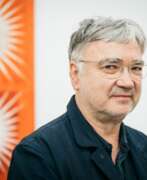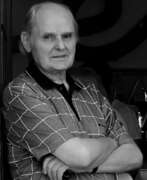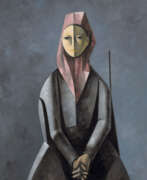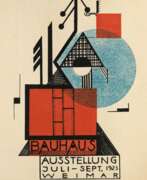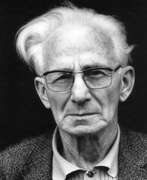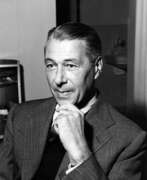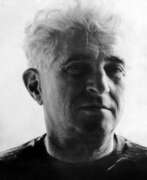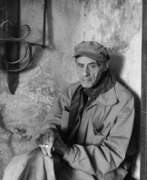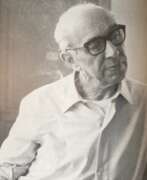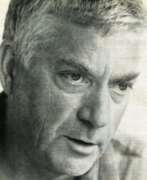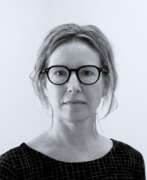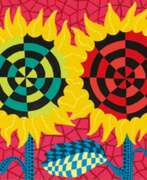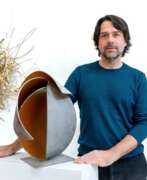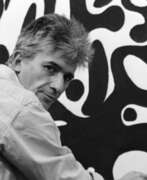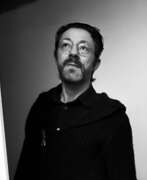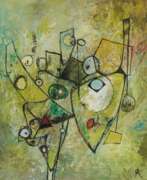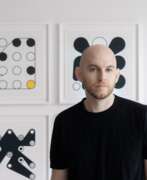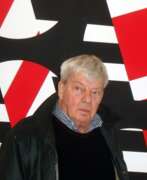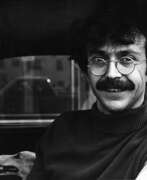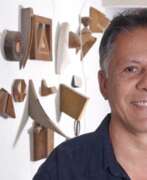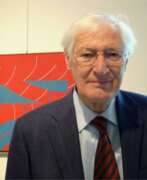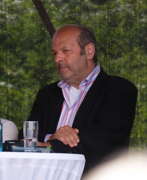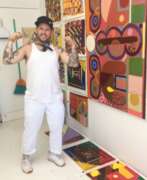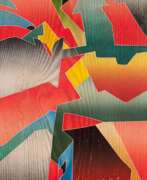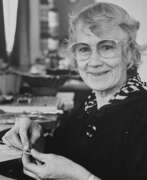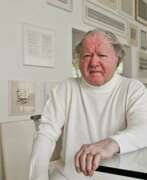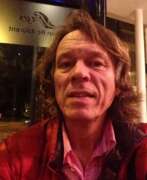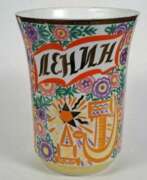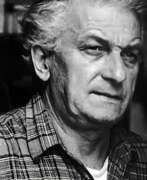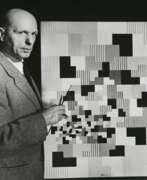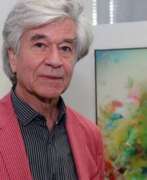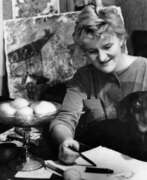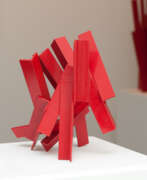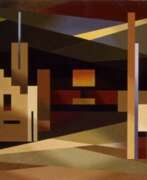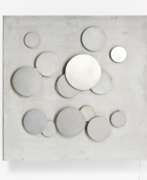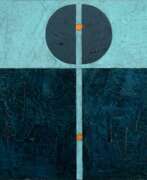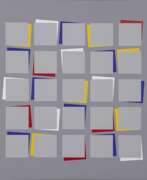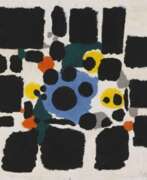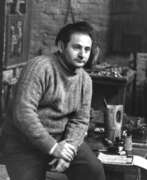Geometric abstraction


Andreu Alfaro Hernández was a Spanish sculptor.
Alfaro learned the principles of geometry and applied his knowledge to create abstract works. His sculptures are usually full of nuances that play with the module, the series and light and color. He was also described as a minimalist artist, albeit with reservations.
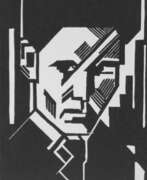

Wobbe Alkema is a Dutch artist, graphic artist, architect, designer and sculptor. He is known for his abstract and geometric works, often combining elements of constructivism and De Stijl.
Alkema was trained as an architect and then turned to art, studying at the Academy of Fine Arts in Groningen. In the 1920s he was involved with the artist collective De Ploeg, which was active in the northern Netherlands and promoted modernist art and culture.
Throughout his career, Alkema continued to explore the principles of abstraction and geometry in his work. His paintings often feature simple geometric shapes such as squares, circles and triangles arranged in complex compositions that suggest movement and depth. He was also interested in the interaction of colour, using bright, bold hues to create dynamic contrasts and harmony.
In addition to painting, Alkema created a number of sculptural works, including abstract reliefs and freestanding sculptures. He also designed furniture and other functional objects, applying his principles of abstraction and geometric form to everyday objects.
Alkema's work is held in the collections of several museums in the Netherlands, including the Groninger Museum and the Amsterdam Stedelijk Museum. He is considered an important figure in the development of abstract art in the Netherlands, and his work continues to be admired for its innovative use of form and colour.
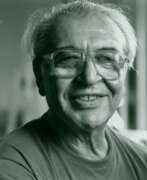

Julio Uruguay Alpuy was an Uruguayan painter, sculptor, and muralist. During his early career, Alpuy was a part of the Taller Torres-García (School of the South) and the constructive art movement. While his early works were greatly influenced by Torres-García's theories about what he called Constructive Universalism, Alpuy drew from a wide variety of cultures and myths to create works that broke the boundaries of the constructive grid. Additionally, his studies in Europe and Latin America helped develop an interest in Cubism and myths that influenced later works. Alpuy had a prolific career and his works are exhibited throughout the world.


Tauba Auerbach is a visual artist working in many disciplines including painting, artists' books, sculpture and weaving. They live and work in New York.
A life-long student of math and physics, Auerbach's work contends with structure and connectivity on the microscopic to the universal scale.
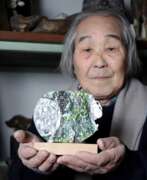

Kenjiro Adzuma (Japanese: 吾妻 兼治郎) is a Japanese abstraction sculptor known for his avant-garde and innovative approach to sculpture and installation art, one of Japan's most important post-World War II artists. He also lived and worked in Italy for many years. He studied sculpture at the Graduate School of Art at the University of Tokyo and at the Brera Academy of Fine Arts in Milan, where he attended Marino Marini's class.
Kenjiro Adzuma was a key figure in the Japanese art movement known as Mono-ha (School of Things) in the late 1960s and early 1970s. Mono-ha artists explored the relationship between natural and industrial materials, often juxtaposing them to create thought-provoking installations.


Alexander Georg Rudolf Bauer was a German-born painter who was involved in the avant-garde group Der Sturm in Berlin, and whose work would become central to the non-objective art collection of Solomon R. Guggenheim.
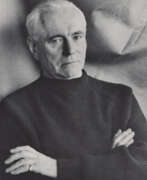

Marcel-Louis Baugniet was a Belgian painter, theorist, furniture designer, creator of posters, costumes and stage sets, and one of the main advocates of the concept of pure plasticity.
He studied painting at the Royal Academy of Fine Arts in Brussels, where he communicated with Paul Delvaux, René Magritte, Victor Servranck and Pierre-Louis Flouquet.
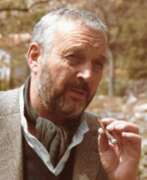

Wolfram Beck was a German sculptor, draughtsman, and painter who worked with wood, steel, bronze, acrylic, and stone. He was trained at the Higher School of Artistic Culture in Berlin, and his work initially included large organic wooden works, portrait busts, and torsos in clay and stone. In the 1970s, Beck created strictly geometric and airy-filigree constructions from mechanical and electronic components that could be moved by actuators or by hand. He also created colorfully accented and fragile looking objects in metal and acrylic. Beck's work can be found in the collections of Axel Springer, Egon Eiermann, and others.


Larry Bell is an American contemporary artist and sculptor. He is best known for his glass boxes and large-scaled illusionistic sculptures. He is a grant recipient from, among others, the National Endowment for the Arts and the Guggenheim Foundation, and his artworks are found in the collections of many major cultural institutions.
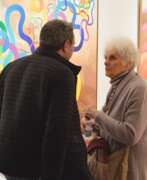

Anna Beothy-Steiner was a Hungarian-French Avant-Garde painter. She studied journalism at the private art school of Álmos Jaschik in Budapest between 1922 and 1925. Her travels to Austria, Germany, and Italy exposed her to the futuristic ideas of Filippo Tommaso Marinetti and the Orphism of Robert Delaunay, both of which influenced her work. Beothy-Steiner moved to Paris in 1927 and married István Beöthy. Between 1927 and 1934, she created her major works, including gouaches, watercolors, magazine illustrations, fabric, and fashion designs. Her compositions during this period were characterized by the interpenetration and superimposition of simple, geometric color surfaces, revealing the influence of her husband's preoccupation with proportions. From 1932 onwards, her compositions contrasted simple colors, creating flat color spaces that anticipated the ideas of Op Art. Beothy-Steiner interrupted her artistic work in 1934 and did not resume until the 1960s, following her husband's death.
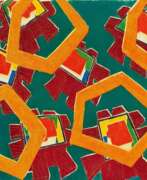

Stefan Berger-Teichmann is a contemporary Swiss painter who specializes in abstract art. He has exhibited his works in various galleries and museums in Switzerland, Germany, and the United States.
Berger-Teichmann's paintings are characterized by their expressive use of color, texture, and form. He often employs a variety of techniques and mediums to create layered, multi-dimensional works that invite the viewer to engage with the art on both a visceral and intellectual level. His work is often inspired by natural landscapes, but he also draws on his own emotional experiences and personal memories to create abstract compositions that are both powerful and evocative.


Charles Bézie is a French artist, representative of the neo-minimalist movement, who lives and works in Paris.
He graduated from the Académie Joulian in Paris and initially tried to create in his paintings a contrast to Malevich and Mondrian. However, he later changed his technique and style. Bezie applies different layers of paint to the canvas, partially overlapping each other, and it is the light that reveals the nuances and shades of the thin and wide stripes. This is what he calls "background animation. Bezie continues the tradition of constructivist art that emerged in the early 20th century.


Gastone Biggi was an Italian painter, sculptor, writer, poet, and musicologist.
Biggi combined painting with his activities as an art writer and musicologist. In 1962 his key work The Birth of the Point was published, theorizing the study of the sign module, which he would develop throughout his life. That same year he formed Group 1.
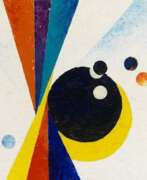

Joseph Binder, full name Joseph Friedrich Gustav Binder, was a German avant-garde painter, designer and graphic artist.
In the early 1930s, Joseph Binder worked on major brand commissions for Knorr, Reemtsma, Tekrum, Elida, Minera, Dujardin, Stella and Mercedes-Benz and earned fame as a style-defining industrial designer. In all, by the early 1960s, Binder had created more than 2,000 stamps and posters.
In painting, Binder favored cubism: geometrically stylized form is of great importance to the painter. He was also influenced by the Bauhaus school of art and the Blue Rider group.


Sebastian Black is a contemporary American artist from New York whose work is stylistically reminiscent of Cubism. The artist is best known for his Puppy Paintings series, in which he depicts puppy muzzles in fragmented abstract shapes and warm tones.
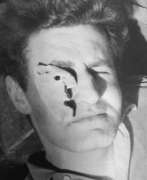

André Borderie is a French artist and sculptor.
Classically trained as a technician and working as a civil servant in the telecommunications sector, André Bordari met the poster artist Paul Colin in 1942, who encouraged him to take up painting.
A fateful meeting with the Austrian sculptors Vera and Pierre Sekely in 1946 led Bordari to the decision to devote himself entirely to art.
André Borderi is known for his paintings, tapestries and ceramics.
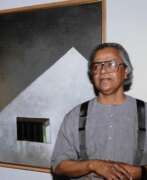

Arun Bose was a prominent Indian artist born in Dhaka, then part of British India (now Bangladesh). He received his art education in Calcutta at the Government College of Arts and Crafts, graduating in 1955. Thereafter, he actively created and taught in Calcutta for the next seven years. In 1962, he travelled to the West where he learnt etching and studied mural techniques at the École Nationale Supérieure des Beaux-Arts in Paris. His many prints were made in aquatint and etching techniques with simultaneous colour printing. He later moved to New York, where he studied at the Pratt Graphic Centre and in 1968 received a scholarship from the Third John D. Rockefeller. He was also part of Robert Blackburn's workshop and taught printmaking himself at Queens College.
Arun Bose's paintings and prints are characterised by bright colours and abstraction, making his work unique and important in the art world.
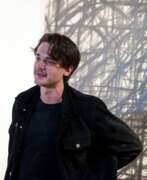

Peppi Bottrop is a German graphic artist who lives and works in Sicily.
He graduated from the Dusseldorf Academy of Arts and has participated in many exhibitions.
Bottrop is a color-blind painter who uses graphite on canvas which he paints directly on the wall. His monochrome paintings depict rectangles, circles and triangles - they are expressive, their skeleton-like abstract outlines reminiscent of a kind of music.


Benjamin Bronni is a German artist, sculptor, and architect.
He studied at the Stuttgart State Academy of Art and Design and works on a symbiosis of painting, sculpture and installations. Bronny has a strong interest in architecture, so he often develops site-specific works. In paper works, paintings and plastic wall objects, Benjamin Bronni explores the rhythmic fusion of form and space. The artist performs his work by hand, but also uses digital processes such as 3D rendering.


Giuseppe Capogrossi was an Italian painter.
In the years following World War II, Capogrossi's work changed in favour of a more abstract style. His work was part of the painting event in the art competition at the 1948 Summer Olympics.
Capogrossi subsequently became one of the main exponents of Italian informal art, together with Lucio Fontana and Alberto Burri.
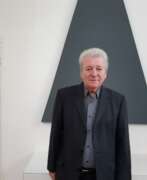

Alan Charlton is a British conceptual artist living and working in London.
Alan studied at Camberwell School of Art and the Royal Academy School, and from the very beginning of his artistic journey, since 1969 he has worked with only one color - gray. For Charlton, it is the most important as well as emotional color in existence, being, for example, the color of melancholy. "I am an artist who makes a gray picture" - this principle he follows all his life.
Alan Charlton creates simple, monochromatic gray abstractions based on rectangular shapes placed in space in a planned way. His conceptual works, uniformly painted in different shades of gray, often consist of simple geometric shapes broken down into modular elements.
Charlton's work has been exhibited at the Stedelijk Museum in Amsterdam, Castello di Rivoli in Turin and the Tate in London.
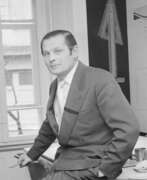

Roman Clemens is a German production designer, designer and scenographer.
Roman Clemens was a student of the Bauhaus, then worked as a scenographer in Dessau and at the Zurich Opera House. Since 1945 he has been involved in various spatial theater projects, worked as a designer for the famous Studio 4 cinema in Zurich, and has done numerous scenic works for the Zurich Opera House.
In the 1970s and 1980s Clemens created paintings in the style of constructivism and abstraction.
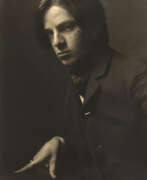

Alvin Langdon Coburn was an American photographer and artist who was best known for his pioneering work in the field of pictorial photography. He was a member of the Photo-Secession movement, which was a group of photographers who sought to elevate photography to the status of fine art.
Coburn was born in Boston, Massachusetts, and grew up in England. He began taking photographs when he was just eight years old and later studied photography in New York City. He went on to become one of the leading photographers of his time, and his work was exhibited widely in Europe and the United States.
Coburn is perhaps best known for his innovative use of the "vortograph," a technique he developed in 1917 that involved photographing objects through a triangular arrangement of mirrors. The resulting images were highly abstract and geometric, and anticipated the work of many later artists, including the Surrealists.
In addition to his work in photography, Coburn was also an accomplished painter and printmaker. He continued to work as an artist throughout his life, and his work is now held in the collections of many major museums around the world.
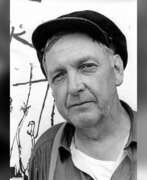

Ernst Stocker, better known as Coghuf, was a Swiss painter, draftsman and sculptor. He designed tapestries and stained glass windows.
Coghuf's work is characterised by abstract forms, bright colours and a sense of dynamic movement. Coghuf's work often conveys emotional depth and explores the relationship between form and space.


Pietro Consagra was an Italian sculptor and one of the leading figures in the post-war Italian art movement known as Arte Informale or Forma 1.
Pietro Consagra's early work was influenced by traditional figurative sculpture, but he soon became fascinated by the abstract art movement. He rejected the idea of creating sculptures that imitated reality and instead focused on exploring the relationship between form, space and the viewer's perception.
Consagra's sculptures often feature simplified geometric forms, emphasising clean lines and solid volumes. His works are characterised by a sense of balance, harmony and spatial tension.
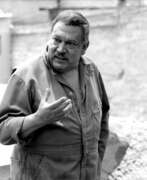

Pedro Coronel Arroyo was a Mexican sculptor and painter, part of the Generación de la Ruptura, bringing innovation into Mexican art in the mid 20th century. Coronel’s training was with artists of the Mexican muralism tradition, with influence from artists like Diego Rivera. This influence remained with the use of pre Hispanic themes and colors in his work. However, his artistic trajectory took him towards more use of color and more abstract forms in his work, due to influences from artists such as Rufino Tamayo. His work was exhibited and gained recognition in Mexico, the United States and Europe. Shortly before his death, he donated his considerable personal art collection to the people of Mexico, which was used to open the Museo Pedro Coronel in the city of Zacatecas.
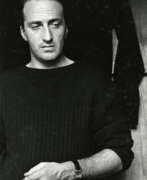

Roberto Crippa was an Italian painter and sculptor. He studied at the Brera Academy of Fine Arts in Milan, where he developed his artistic skills by exploring different styles and techniques.
Crippa's early work was influenced by Surrealism, with its dreamy and symbolic images. However, he soon moved away from figurative representation and began to use abstraction. His artistic style evolved into a unique combination of abstraction and geometric forms.
One of Crippa's notable contributions to art was his involvement in the Movimento Arte Concreta (Concrete Art) movement in Italy. This movement advocated non-representational art, emphasizing geometric forms, mathematical precision and a focus on the formal aspects of art. Krippa's work from this period demonstrates a fascination with grids, lines and geometric patterns.
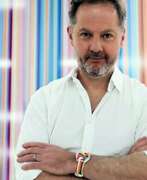

Ian Davenport is an English abstraction artist known for his intricate compositions of streams of colored paint flowing over surfaces. All of Davenport's work involves experimentation: he uses various industrial and domestic tools, including wind machines, hypodermic syringes, and watering cans, to manipulate the paint and to draw as much attention to the process of creating artwork as to the finished works themselves.


Fernando de Szyszlo Valdelomar was a Peruvian painter, sculptor, printmaker, and teacher who was a key figure in advancing abstract art in Latin America since the mid-1950s, and one of the leading plastic artists in Peru.
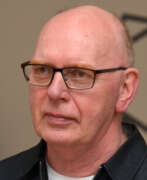

Richard Deacon is a Welsh sculptor. He is known for his abstract sculptures that explore the relationships between form, space, and materials.
Deacon initially studied at the Somerset College of Art in Taunton before going on to study at the Central Saint Martins College of Art and Design and the Royal College of Art in London. He began his career as a sculptor in the 1970s and has since become one of the most prominent British sculptors of his generation.
Deacon's sculptures are often made from materials such as laminated wood, steel, and ceramics, and take on a wide range of forms, from organic and biomorphic to geometric and architectural. He is known for his use of curves, lines, and bold colors, as well as his exploration of negative space and the relationship between objects and the space around them.
Deacon has exhibited widely throughout the world, including at the Tate Gallery in London, the Museum of Contemporary Art in Los Angeles, and the Guggenheim Museum in New York. He has been awarded numerous honors for his work, including the Turner Prize in 1987 and a CBE in 1999.


Felix del Marle is a French artist and designer associated with the avant-garde movements of the early 20th century, in particular Orphism and De Stijl. Originally influenced by Cubism, he later adopted the principles of Orphism, a movement founded by Robert Delaunay and characterised by the use of bright colours and geometric shapes to create abstract compositions.
Felix del Marle explored the dynamic interaction of colours and shapes to evoke a sense of rhythm and movement. His works often feature overlapping planes, bold colour contrasts and a sense of optical vibrancy.
Felix del Marle was also a significant influence on the De Stijl movement, which sought to reduce art to its basic geometric elements and colours. He collaborated with Piet Mondrian and Theo van Doesburg.
In addition to painting, del Marle pursued industrial and graphic design, applying his principles to furniture, textiles and typography. He believed in the integration of art into everyday life and the synthesis of artistic disciplines.


Sonia Delaunay-Terk (Russian: Соня Делоне-Терк) was a Russian-French painter and designer of Jewish descent. She received the name Sonia Terk, by which she is known, in 1890 after being adopted by her uncle. She is also called Sonia Delaunay in literature. She is considered a representative of geometric abstraction. Her artistic role models include Vincent van Gogh and Paul Gauguin. From 1912, she developed the so-called Orphism with her husband Robert Delaunay.
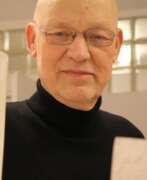

Ludwig Dinnendahl was a German sculptor and teacher.
He studied at the colleges of fine arts in Frankfurt and Pforzheim. In his sculptures Ludwig Dinnendahl focuses on clear geometric forms, he used bronze or cast iron, stone and plaster as well as wood as materials. His works are represented in the public spaces of many cities and towns in the country.
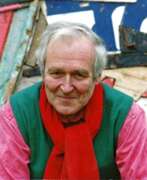

Bertrand Dorny is a French abstractionist artist, painter, printmaker and graphic designer.
Originally a painter, Dorny became interested in various techniques, particularly printmaking, in which he achieved great success and recognition. He created more than 650 engravings.
Dorny enjoyed working with wood and paper, from which he created intricate collages, reliefs, and assembled large wooden panels. He also worked in the field of book collage.
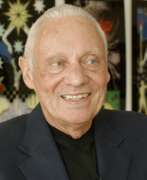

Ugo Dossi is a German conceptual artist.
Typical of his work is the use of forms of representation of the infinite, which lead the mind to the perception of the infinite and incomprehensible, which lies behind everything.
His installations have been shown twice at Documenta (Documenta 6 and Documenta 8), the Venice Biennale (1986 and 2011), Paris (1975) and Buenos Aires (2000) as well as numerous solo exhibitions in international museums and institutions.


Teo Eble was a Swiss abstractionist painter and graphic designer.
Eble studied at the Academy of Fine Arts in Berlin, then taught at the Basel School of Applied Arts from 1931 to 1967. In 1933 he co-founded the Swiss Group 33, an anti-fascist association of artists.
His work was influenced by the realist, objective painting of the 1920s. The subjects of Eblé's early works were landscape paintings and depictions of cities and their life.
In 1934, Eblé began abstract painting and became a prominent artist of the abstract movement in Switzerland and was also recognized internationally. He held exhibitions in France and the United States, in 1958 at the Venice Biennale and in 1959 at Documenta in Kassel. In the 1960s, Eblé created numerous murals in public buildings.


Georg Engst was a German sculptor.
Engst preferred to work in wood, stone and bronze, but also in aluminium, concrete and glass. Much of his artistic work from the mid-1950s onwards is abstract-geometric in character, initially in the form of inlaid panels and inlaid walls made of wood, for example for a commission for the conference room of the Regional Church Office in Hanover in 1957.
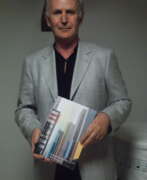

Albert Ennemoser is a contemporary Austrian artist. Traveled extensively throughout Europe, USA, Africa and Asia. In 1972 he immigrated to Ireland, then moved to Scotland. He studied painting at the Glasgow School of Art and Jordanhill College of Education. Worked as an illustrator for BBC-TV-Scotland and as a designer for NAEF in Switzerland. He received several awards and was artistic director of the Tiroler Literaturwettbewerb für Jugendliche. His work has been exhibited both nationally and internationally.


André Evard was a Swiss painter and drafter. His special significance lies in the field of constructive art. He is counted among the first artists who did not work figuratively. In the course of his life he produced hundreds of oil paintings, a large number of drawings as well as approximately 2000 to 3000 watercolor and gouache paintings.
André Evard's work is difficult to classify in the categories of art history. He was not committed to any particular style, but rather reverted to the past, mixed styles and invented something new. Art Nouveau, Cubism, and geometric-constructive abstractions all define his work. While in Paris he was part of the avant-garde, he later repeatedly withdrew to representational painting.
On the one hand, the play of forms and colors leads to highly expressive representational landscapes, on the other hand, fascinating still lifes emerge from the clear reduction, which show unusual color combinations and completely new object-space relationships. In doing so, he always exposed himself to the risk of a stylistic break, which, however, is the special feature of his artistic oeuvre. He painted abstract when hardly anyone painted abstract and returned to representational painting when Abstract art dominated.


Gerhard Fietz was a German painter, professor and representative of non-objective painting. He is considered an important painter of the second half of the 20th century in Germany.
As a co-founder of the artist group ZEN 49, he opposed traditional representational art and, together with painters such as Willi Baumeister, Fritz Winter and Rupprecht Geiger, developed a style of painting that focused on experimenting with artistic means. Fietz exhibited at numerous national and international exhibitions, including the highly regarded exhibition at the Cercle Volnay in Paris in 1955.
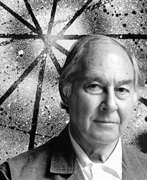

Gordon Onslow Ford was a painter, watercolourist and draughtsman.
At the time of his death at his home, he was among the last of the Parisian Surrealist group, which he joined in 1938. While still in Paris before the Second World War, Onslow Ford developed a technique called coulage, anticipating the method made famous by Jackson Pollock. By letting enamel paint flow freely onto a canvas, he took advantage of the effects of chance so admired by the Surrealists in their quest for automatic processes that could tap into the unconscious. Sometimes he superimposed lines and geometric shapes on fluid, indeterminate forms to bring order and stability to the canvas. In the same years, he also produced landscapes full of biomorphic forms. Finely crafted paintings of this type, often incorporating cryptic symbols, continued to evolve for some time thereafter. In California, he continued his quest to represent an inner world in harmony with nature by imagining ineffable ethers supporting abstract forms and floating points of light.
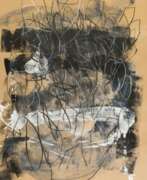

Christoph M. Gais is a German abstractionist painter and designer. He studied painting at the Academy of Fine Arts in Stuttgart and at the Hochschule für Kunst in Berlin, where he received his master's degree. Christoph M. Geiss's paintings are based on the tradition of gestural abstract painting. His work also includes several art projects in architecture, such as the design of the Louise Schroeder Hall at the Red City Hall in Berlin.
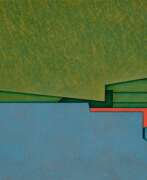

Gunther Gerzso was a Mexican painter, designer and director and screenwriter for film and theatre.
Gunther Gerzso was awarded the Guggenheim Fellowship in 1973 and later in 1978 he was the recipient of the Premio Nacional de Bellas Artes.


Torben Giehler is a German abstraction artist.
After studying at the Boston Academy of Art he returned to Germany.
Giehler's style of painting is based on abstract compositions of geometric forms. He digitally edits his sketches and then uses multiple layers of acrylic paint to create large-scale works. In this way the artist manages to convey his own impressions of mountains, streets or buildings.
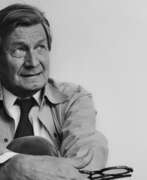

Werner Mathias Goeritz Brunner was a Mexican painter and sculptor of German origin. After spending much of the 1940s in North Africa and Spain, he and his wife, photographer Marianne Gast, immigrated to Mexico in 1949.
In 1953 he first presented his "Manifiesto de la Arquitectura Emocional" (Emotional Architecture Manifesto) at the pre-inauguration of the Museo Experimental El Eco in Mexico City, which he designed in 1952-53. During the 1950s, Goeritz also collaborated with Luis Barragán to make monumental abstract sculptures in reinforced concrete, including El animal del Pedregal (The Animal of the Pedregal, 1951) and the Torres de la Ciudad Satélite (Towers of Satellite City, 1957).


Gertrud Goldschmidt, full name Gertrud Louise Goldschmidt, also known by her pen name Gego, is a Venezuelan painter, architect and sculptor of German descent.
She graduated from the University of Stuttgart with a degree in engineering and architecture, and emigrated to Venezuela with the outbreak of World War II, settling in Caracas. Gertrud Goldschmidt was engaged in design and architectural commissions. And she began her artistic career in the 1950s, developing her own style of geometric abstraction, which became a symbol of artistic modernity in Venezuela.
Gego then began to create sculptures and wire mesh constructions, and was also active in kinetic art. In 1969, the Museum of Fine Arts in Caracas exhibited her three-dimensional installation consisting of an extensive modular wire mesh that unfolds in the gallery space through the floor, walls and ceiling. Goldschmidt is best known for her geometric and kinetic sculptures made in the 1960s and 1970s.
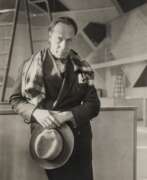

Werner Graeff was a German sculptor, painter, graphic artist, photographer and inventor.
His first paintings were in the Impressionist style. Around 1919 he turned to cubist forms. This style also influenced his early sculptures.
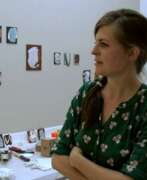

Henriette Grahnert is a German artist, designer and graphic artist. She graduated from the Academy of Art and Design in Leipzig and works in Dresden and in Leipzig.
The artist uses and combines a variety of painting traditions: classical abstraction and concrete painting, minimalist traditions and bad painting, American color field painting and pop art. Peeling paint, random brushstrokes, drips, smudged duct tape - remnants of the painting process are the elements that make up Grahnert's paintings.
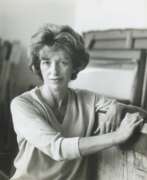

Sarah Grilo was an Argentine painter who is best known for her abstract gestural paintings. Married to the artist José Antonio Fernández-Muro, she lived in Buenos Aires, Paris, New York and Madrid.
She is considered one of the most important Latin American artists of the 20th century.


Joachim Grommek is a German artist known for his conceptual work. His geometric-abstract, illusory work perfectly reverses the theme of the original image and the copy, reflecting the history of art.
Grommek has exhibited his work widely in Germany and abroad. He has also received numerous grants and awards for his work.


Michel Guillet is a French artist. He is known for his contemporary and abstract works of art. Guillet studied at the École de Beau-Ar in Lyon.
Guiller's work is characterised by bright colours and geometric shapes, often organised into complex and dynamic compositions. He has exhibited his work in galleries and museums throughout France and Europe and his paintings are held in private collections all over the world.
In addition to his work as an artist, Guillé has also been involved in art teaching and education. He taught at the Ecole Nationale Supérieure des Arts Décoratifs in Paris and ran painting and drawing workshops in various locations in France.
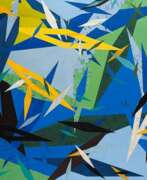

Dieter Haack is a German abstractionist painter.
Dieter Haack studied painting at the Düsseldorf Academy of Fine Arts. His works are characterised by bold colours and energetic compositions.
In addition to his art practice, Haack also worked as a professor of painting and drawing at his alma mater.


Herbert Hamak is a German installation artist and sculptor who lives and works in Hammelburg, Germany.
Herbert Hamak's works are somewhere between painting and sculpture and are the result of a combination of form, color and light. Herbert Hamak works with pigment and mass; he shapes and transforms them into simple monochromatic forms - cubes, parallelograms and columns. Hamak often uses buildings, their facades, their spaces as a canvas or frame for a work of art.
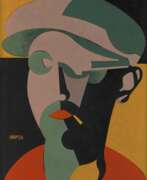

Karl Hermann Haupt was a German painter, graphic artist and designer.
He studied painting at the Art School in his native Halle from 1920 to 1923. From 1923 to 1924 he attended courses at the Bauhaus in Weimar, where his teachers included Josef Albers, Laszlo Mohoy-Nagy, Wassily Kandinsky, Paul Klee and Walter Gropius. After his studies at the Bauhaus, Haupt returned to Halle, where he worked as a painter until 1926. He then moved to Krefeld to begin a career as a textile painter. Haupt remained in Krefeld for most of the 1930s, combining painting with his studies with Johannes Itten at the Krefeld School of Textile Decoration.
After military service during World War II, Haupt worked for the regional government of Saxony-Anhalt until 1951, when he was appointed lecturer at the School of Applied Art in Berlin. From 1953 he worked as a scientific illustrator and photographer at the Academy of Sciences in Berlin until his death.
Haupt's paintings and graphics often depicted urban scenes and industrial landscapes, and he was particularly interested in the human figure and the impact of modern society on the individual. His work was known for its sharp, crisp lines and attention to detail.
Today, Haupt's work is recognized as an important contribution to modern art in Germany, and his paintings and drawings are in the collections of major museums around the world.
